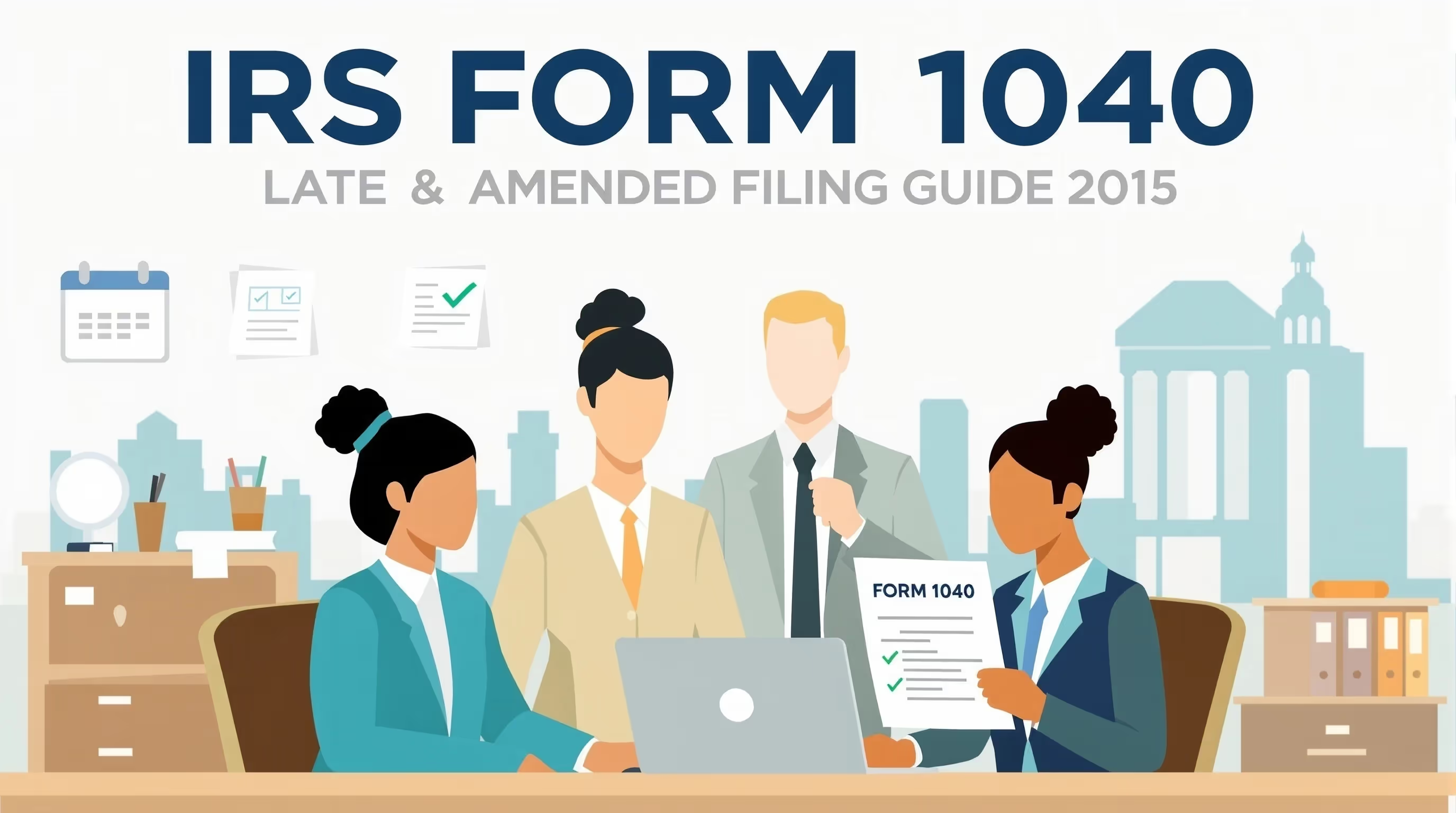Formulario 1040 (2015) del IRS: Guía de presentación tardía y enmendada

Para qué sirve el formulario 1040 (2015) del IRS
Formulario 1040 del IRS (2015) es la declaración federal de impuestos estándar que se usa para declarar sus ingresos, deducciones y créditos y calcular su obligación tributaria para el año tributario 2015. La mayoría de los ciudadanos estadounidenses y extranjeros residentes deben presentar esta declaración de impuestos si sus ingresos brutos alcanzan ciertos límites: 10 300 dólares para personas solteras menores de 65 años, 20 600 dólares para las personas casadas que presentan una declaración conjunta o 4 000 dólares para las personas casadas que presentan una declaración por separado (instrucciones del IRS para el formulario 1040 (2015)).
Este formulario de impuestos informa los ingresos por salarios, pensiones, beneficios del Seguro Social, anualidades, ganancias de capital e intereses de instituciones financieras. También determina la cantidad de impuestos federales que debe o si reúne los requisitos para recibir un reembolso. Los contribuyentes elegibles pueden solicitar créditos tributarios, como el crédito tributario por ingreso del trabajo y el crédito tributario por hijos, para reducir su factura tributaria total. Proporcionar información precisa garantiza que su estado civil, su número de identificación fiscal y sus deducciones sean correctos antes de presentar la declaración.
Cuándo utilizaría el formulario 1040 para 2015 (presentación tardía o enmendada)
Usaría el formulario 1040 para 2015 si nunca presentó su declaración de impuestos federales original o si necesita corregir errores en una presentación anterior. La presentación tardía a menudo ocurre cuando adeuda impuestos y quiere eliminar las multas o cuando aún reúne los requisitos para solicitar un reembolso antes del plazo de tres años. Si necesita corregir errores, como ingresos incorrectos, deducciones omitidas o cambios en el estado de presentación de la declaración, debe presentar una declaración enmendada mediante el formulario 1040X. La presentación inmediata limita las multas por pago atrasado y, si no puede pagar la totalidad de la factura tributaria, puede solicitar un plan de pago a través del IRS para administrar su saldo.
Reglas clave específicas de 2015
El año tributario 2015 tuvo una exención personal de 4.000 dólares por persona y montos de deducción estándar de 6.300 dólares (solteros), 12.600 dólares (casados que presentan una declaración conjunta), 6.300 dólares (casados que presentan una declaración por separado) y 9.250 dólares (cabeza de familia). La fecha límite para presentar la solicitud fue el 18 de abril de 2016 (19 de abril para Maine y Massachusetts).
Las reglas clave específicas de 2015 incluyen:
- Introducción de las cuentas de jubilación myRA para depósitos de reembolso
- Restablecimiento del crédito tributario para la cobertura de salud con efecto retroactivo a 2014
- Pagos de responsabilidad compartida más altos por falta de cobertura médica
- Nuevas cuentas ABLE para ahorros por discapacidad con contribuciones de hasta 14 000 dólares
Paso a paso (nivel alto)
- Reúna transcripciones y registros: Solicite al IRS transcripciones de salarios e ingresos, transcripciones de cuentas y cualquier documento tributario del año anterior para asegurarse de informar correctamente todos los ingresos, retenciones y pagos. Incluya los estados de cuenta, los formularios de pensión y los registros financieros proporcionados por el empleador.
- Complete el formulario del año correcto: Utilice la versión 2015 del formulario 1040 y los anexos aplicables, disponibles en la sección de formularios del año anterior del IRS. Siga atentamente la ley tributaria federal y los umbrales de ingresos de 2015.
- Adjunte todos los horarios requeridos: Incluya todos los anexos necesarios (A, B, C, D, E, etc.) y los formularios pertinentes, como el formulario 8962 para la conciliación de créditos tributarios para las primas o el formulario 8965 para las exenciones de la cobertura médica. Adjunte todos los documentos que justifiquen las deducciones, los créditos o las distribuciones para la jubilación.
- Elige el método de presentación: Envíe las devoluciones en papel a la dirección que aparece en las instrucciones de 2015 o preséntelas electrónicamente si su software admite envíos del año anterior. Asegúrese de que todos los formularios estén completos y firmados antes de enviarlos por correo.
- Guarde copias y confirmaciones: Guarde copias de todos los formularios, anexos y documentos de respaldo pertinentes, así como comprobantes de envío por correo o confirmación de presentación electrónica. Conserve estos registros durante al menos tres años.
Errores comunes y cómo evitarlos
- Números de Seguro Social faltantes o incorrectos: Verifique todos los números para usted, su cónyuge y sus dependientes. Los errores pueden retrasar el procesamiento y provocar la pérdida de ciertos créditos tributarios.
- Errores matemáticos o de cálculo: Use software o verifique los cálculos, especialmente al detallar las deducciones o aplicar los créditos fiscales, para evitar demoras en el procesamiento o ajustes de reembolsos.
- Informes de ingresos incompletos: Compare su declaración con todos los formularios W-2, 1099 y estados de pensión. La falta de ingresos de los empleadores, las anualidades o los intereses puede generar notificaciones del IRS.
- Estado de presentación incorrecto: Elija el estado tributario correcto para 2015, ya que determina su deducción estándar y su elegibilidad para los beneficios tributarios.
- Olvidar los formularios obligatorios: Adjunte el formulario 8962 para los créditos tributarios para las primas, el formulario 8965 para las exenciones de cobertura médica y cualquier otro anexo requerido.
- No conciliar la cobertura de salud: Complete las líneas 61 y 69 para los créditos tributarios para el seguro médico y las primas para evitar demoras en el procesamiento.
Qué sucede después de presentar la solicitud
El IRS generalmente procesa las declaraciones en papel en un plazo de seis a ocho semanas; sin embargo, el procesamiento puede demorar más en casos complejos relacionados con deducciones detalladas, ingresos comerciales o distribuciones de jubilación. Recibirá avisos confirmando la recepción y cualquier ajuste que se haya realizado.
Si adeuda impuestos adicionales, el IRS le enviará una factura con su saldo total, incluidas las multas y los intereses. Puede hacer pagos electrónicamente, por correo o a través de instituciones financieras. La presentación suspende la multa por no presentar la solicitud, aunque los intereses continúan hasta que se pague el saldo total. Los contribuyentes que tengan dificultades financieras pueden comunicarse con el Servicio del Defensor del Contribuyente para obtener ayuda.
Puede verificar el estado de su reembolso utilizando la herramienta «Dónde está mi reembolso» en IRS.gov, que se identifica con el ícono de un candado cerrado para un acceso seguro. Guarde sus documentos de respaldo, cronogramas y recibos durante al menos tres años después de presentar su declaración de impuestos.
Preguntas frecuentes
¿Puedo seguir recibiendo un reembolso por mis impuestos de 2015 si presento la declaración fuera de plazo?
Sí, aún puedes solicitar un reembolso si lo presentas antes del 18 de abril de 2019, es decir, tres años después de la fecha de vencimiento original. Después de esa fecha, los reembolsos no reclamados vencen, incluso si se retuvieron impuestos de su salario.
¿Qué multas tendré que pagar por presentar mi declaración de 2015 con retraso?
La multa por no presentar la declaración es del 5% de los impuestos impagos por mes, hasta un máximo del 25% por año. Los intereses se acumulan diariamente sobre las multas y los impuestos impagos. La presentación de la declaración, incluso si no puede pagar de inmediato, limita las multas por pago atrasado.
¿Cómo puedo obtener mis transcripciones de impuestos para ayudarme a completar mi declaración de impuestos atrasada?
Solicite las transcripciones en línea en IRS.gov/Transcripts, llamando al 800-908-9946 o enviando por correo el formulario 4506-T. Las transcripciones de salarios e ingresos muestran los datos reportados por los empleadores, las pensiones y las instituciones financieras para ayudarlo a completar su declaración.
¿Debo presentar también una declaración estatal enmendada si presento una declaración federal tardía?
Sí, muchos estados exigen una declaración de impuestos estatal enmendada cuando cambia el ingreso bruto ajustado federal. Comunícate con la agencia tributaria de tu estado para determinar si debes presentarla y qué formularios se requieren.
¿Puedo presentar electrónicamente mi declaración de 2015 o debo enviarla por correo?
Algunos proveedores de software siguen admitiendo la presentación electrónica de declaraciones de años anteriores, pero muchas de las declaraciones de 2015 deben enviarse por correo. Use la dirección que figura en las instrucciones del formulario 1040 de 2015 y firme antes de enviarlo.
¿Cómo debo proceder si no puedo pagar los impuestos adeudados en mi declaración de 2015?
Presente su declaración de todos modos para evitar nuevas sanciones. Luego, solicite un plan de pago del IRS mediante el formulario 9465 o la solicitud de pago en línea si adeuda 50 000$ o menos en impuestos, intereses y multas combinados.
¿Cuánto tiempo debo guardar los registros después de presentar mi declaración de finales de 2015?
Guarde los registros tributarios, los formularios, los anexos y los documentos de respaldo durante al menos tres años a partir de la fecha de presentación. Consérvelos durante más tiempo si solicitó ciertas deducciones, declaró ingresos inferiores a los declarados o recibió distribuciones que podrían requerir una verificación futura.











